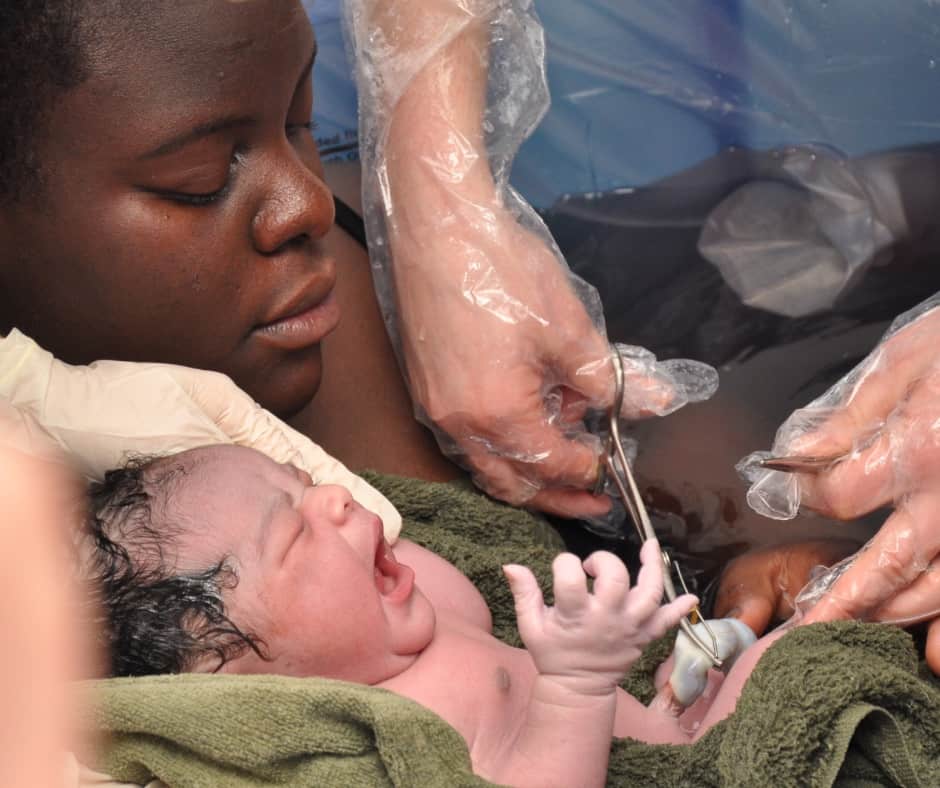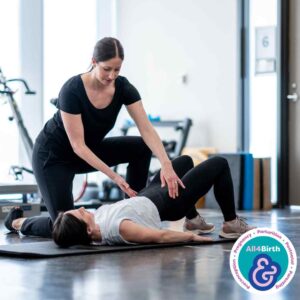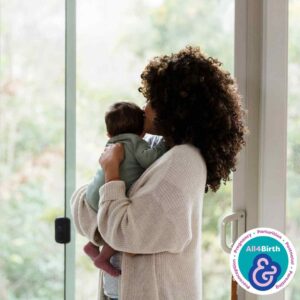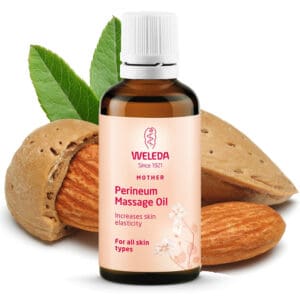Factsheet: Severe Perineal Trauma
Cheryl Samuels
Midwife at Mid and South Essex NHS Hospital Trust
Project Lead at All4birth
BSc (Hons) Midwifery, Professional Midwifery Advocate
Instagram @the_holistic_midwife
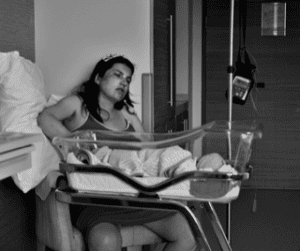
Summary
It is common for soft tissue damage to occur during the birth of a baby, in the U.K around 85% of women and birthing people will experience some trauma to the genital tract. Most of these tissue traumas will heal well, causing no long-term morbidities. However, obstetric anal sphincter injury (OASI), which is the shared term for third- and fourth-degree perineal tears, is a severe complication of vaginal birth.1 This high level evidence factsheet will explore severe perineal trauma, the concept of risk, pathophysiological effects of severe perineal trauma, wider determinants and the role of the midwife and care providers.
A third degree tear is when the muscle of the anal sphincter is injured. The following grades specify the severity of the damage:
Grade 3a tear: Less than 50% of external anal sphincter (EAS) thickness torn.
Grade 3b tear: More than 50% of EAS thickness torn.
Grade 3c tear: Both EAS and internal anal sphincter (IAS) torn.
A fourth degree tear is when there is injury to perineum involving the anal sphincter complex (EAS and IAS) and anorectal mucosa.
Specialist obstetric surgical repair in theatre is needed to ensure the best chance of resuming normal anal function in the future.2,3 The Royal College of Obstetricians and Gynaecologists (RCOG) reports the rate of OASI (in singleton, term, cephalic, vaginal first births) in England has tripled from 1.8% to 5.9% from 2000 to 2012.3 The average overall incidence in the UK is 2.9% (range 0–8%), with an incidence of 6.1% in first time mothers, compared with 1.7% in subsequent births.3 The increase in incidence rate has been linked to the improvement of recognition and classification of trauma, but also the variations in intrapartum practice, including sub-optimal episiotomy use and the varying practices of perineal protection including the possible misinterpretation of the HOOP trial and the use of ‘hands on’ or ‘hands off’ approach to perineal protection.4,5,6
The cause of OASI is multifaceted, risk factors including primiparity, fetal macrosomia, operative vaginal delivery, prolonged second stage, epidural analgesia, Asian ethnicity, midline versus lateral episiotomy, shoulder dystocia, persistent occipito-posterior position and increasing maternal age are well-known risk factors for OASI.1,3,6,8,9 There is, however, considerable difference in the reported risks for the same risk factor.3 Incidence varies significantly between populations and time periods (0.6–6.6%) and this variance has not been fully explained by known risk factors.10
Concept of risk
There were no systematic reviews or randomised controlled trials to suggest a preferred mode of birth following OASI, however, women who suffer an OASI are 20 times more likely to have a planned caesarean birth in subsequent pregnancies.11 According to the RCOG the risk of sustaining a further third- or fourth-degree tear after a subsequent delivery is 5–7%, with 17% of women developing worsening faecal symptoms after a second vaginal delivery.3 This seemed to occur if there had been faecal incontinence beyond three months but resolution by six months after the index delivery.3
However, in comparison Priddis et al found in a large population-based data linkage study of over 500,000 births in New South Wales between 2000-2008, that first time mothers who experienced severe perineal trauma, were no more likely to have another severe tear in a subsequent birth.12
There are no studies to suggest that prophylactic episiotomy in the subsequent birth would prevent OASI. The need to perform an episiotomy during a subsequent birth after previous OASI, should be a clinical assessment independent of the previous OASI.3
Therefore, it is important to discuss these findings and statistics with women and to take into consideration a woman’s individual experience and symptoms, when providing evidence-based information in the event of planning care and subsequent birth preferences.13
Downe and Byrom demonstrate a balanced view on the concept of risk in maternity care with the following quote from their book ‘Squaring the circle’ – “Where the focus is on possible physical harms, other important aspects of wellbeing, such as psychological, social, cultural, and spiritual needs, and even longer-term adverse clinical effects for mother and baby, become less relevant. The irony is that by ignoring these important aspects of what makes us human, other unexpected risks emerge as women try to circumnavigate the trauma inflicted by their depersonalised and dehumanised care”.14
It is an essential role of the midwife and care providers to facilitate personalised care and to advocate for women and their individual choices.13,16 Using terms such as additional care needs instead of ‘high risk’ and ‘chance of’ instead of ‘risk of’ could help to soften the medical model and care terminology with an aim to reducing anxiety for women in future pregnancies.
Pathophysiological effects
The physical morbidities and co-morbidities caused by OASI include chronic pain, urinary, flatus and faecal incontinence, dyspareunia, pelvic organ prolapse, vesicovaginal fistulas and increased rates of caesarean section in subsequent deliveries.1,3,16 The RCOG report that several randomised controlled studies carried out since 2000 comparing overlap and end-to-end techniques of EAS repair have reported low incidences of anal incontinence symptoms in both arms, with 60–80% of women described as asymptomatic at 12 months.3 Also, Nilsson et al found that prevalence of anal incontinence symptoms is likely to increase with maternal age.17 However, that is still a substantial number of women living with sometimes debilitating symptoms for over a year after the birth of their child, and further research, funding and rehabilitation services are needed to support these women.18
Bick, Hall and Keighley reported from their survey of 325 women with OASI injury that pain was a prominent physical issue of participants, in particular if repairs had become infected or there was significant scar tissue.18 During surgical repair correct re-alignment of the tissues is essential to prevent scar tissue formation. If wounds are gaping, they will heal by granulation and scar tissue is formed, this causes a rigid misshapen perinium and can cause dyspareunia (pain on intercourse).2
Pudendal neuralgia is a long-term pelvic pain that originates from damage or irritation of the pudendal nerve and is a more debilitating and neglected cause of pain.18 It can affect the sacral plexus, with pain referred beyond the perineum, leading to hyperaesthesia (excessive physical sensitivity) of the vulva and anal margin and sensory disturbance and awareness in the bladder, anorectum and vagina, leading to incontinence and sexual dysfunction.18
Additional causes of incontinence can be if the surgical repair was unsuccessful in achieving normal anorectal manometric pressures, missed diagnosis of severity of trauma after childbirth and breakdown or infection of the wound site affecting correct alignment and healing.3,18 In the U.K there is a lack of high-quality research into the long-term physical effects of OASI and further studies in this area will help to provide evidence to improve postnatal services and rehabilitation for women who have suffered OASI.
Wider determinants
There are many psychosocial challenges that are caused by OASI such as birth trauma, post-traumatic stress disorder (PTSD), depression and anxiety, social isolation and marginalisation, difficulty in maintaining sexual relationships and the bonding process between mother and infant with poorer quality of life at even 10 years postpartum.19 In Lindqvist et al qualitative study of women’s experiences one year after OASI at childbirth they found that many women still struggled to settle into their damaged bodies. More than 64% of 625 participants reported some degree of pain during sexual intercourse. Feelings of guilt, frustration and shame were mentioned and reports of experiencing lower self- image, with one third of participants reporting persisting anxiety and depression at one year postpartum.19
Gommesen et al also reported that 53% of first time mothers women with a third- or fourth-degree tear reported dyspareunia, compared to 38% of women with a second-degree tear at 12 months postpartum. Concluding that it is important to council women about sexuality during and after pregnancy and to minimise the extent of perineal trauma at birth where possible.20
Priddis, Schmied and Dahlen describe three themes found in their qualitative study exploring women’s experiences following severe perineal trauma, ‘The Abandoned Mother’ describing how women felt vulnerable, disempowered, and exposed. ‘The Fractured Fairytale’ explored the disconnect between the expectations and the realities of their birth experience and the postnatal period, with women reporting how it negatively impacted their ability to bond with their baby, move independently, breastfeed, and perform basic parenting tasks in the first few weeks due to pain and symptoms of OASIS. ‘A Completely Different Normal’ explored how women navigated different treatment pathways, a level of acceptance and coping mechanisms if they experience long term perineal morbidity.16
The MASIC Foundation is the only multi-disciplinary UK charity to support women who have suffered severe injuries during childbirth. In their survey Bick, Hall and Keighley found that of 325 responses 85% of women said it impacted on their relationship with their child, with one mother stating “I believe I never bonded with my child because of the injuries, not being able to move/take her out of the crib for the first few days, because of the pain I was in”. 78% of women were affected by traumatic memories of birth and 49% of women doubted their ability to mother.18 All of these studies and surveys devastatingly demonstrate the wider social and psychological impact of OASIS on women and their families, which can have long term impacts on their quality of life and decision whether to have a subsequent baby.
Role of the midwife and healthcare providers
Full-scope midwifery defined by the Lancet Midwifery Series includes the optimisation of normal biological, psychological, social, and cultural processes whilst respecting women’s individual circumstances and views.21 Women experiencing an additional care needs pregnancy are more likely to have their mental health impacted negatively, with a significantly higher level of stress.22 Therefore, it is essential when caring for a woman deemed ‘high risk’ or with additional care needs due to previous OASIS, the midwife encourages and empowers them to share in decisions about their treatment and care to provide psychological safety.13
Feeley, Thompson and Downe discuss the barriers that can make supporting these individual circumstances and views difficult, such as hyper-adherence to population-based guidelines, fears of adverse outcomes and potential reprisals or litigation.23 In the U.K the report Better Births aims to provide greater personalised care in maternity services, therefore midwives need to feel confident in advocating for women’s individual circumstances and choices which may fall outside of local or national guidelines.15
Feeley developed the ASSET model to highlight midwives as an ‘asset’ for women getting their needs met and what midwives need from an individual to an organisational level in providing personalised positive care and advocating for women’s individual choices.24
A – Autonomy, Access and Apply evidence-based information to individual women
S – Skills – physiological birth experience and skills in a range of settings, Skill development and ongoing CPD
S – Systems approach that supports woman-centred care/full-scope midwifery, Support (accessible, timely, restorative psychological safety)
E – Empathy and compassion (for women and from colleagues), Emotional intelligence
T – Trusting relationships; with women, colleagues, employers
The Asset model can be applied to care planning for women with obstetric complexities, helping to provide women-centred care, informed decision making, and trauma informed positive birth outcomes.15
Care plan
During a booking appointment if the woman or pregnant person discloses a previous OASI during their obstetric history taking, referral should be made to consultant led care. The RCOG recommends that all women who have suffered OASIS should be counselled regarding the choice of mode of delivery and this needs to be clearly documented in the maternity notes and states “If the woman is symptomatic or shows abnormally low anorectal manometric pressures and/or endoanal ultrasonographic defects, an elective caesarean section may be considered.”3
A midwife’s role is to provide evidence-based information and education during pregnancy, this could be in the form of written patient information leaflets discussing antenatal perineal massage from 32 weeks of pregnancy which is shown to reduce the risk of severe perineal tears.13,25 The RCOG recommend antenatal discussion of OASI with all women and what can be done to minimise their risk in the antenatal and intrapartum periods.3
Discussion in the antenatal period should take place regarding a plan of care if the woman chooses to have a vaginal birth. In the U.K sixteen NHS Trusts implemented the OASI Care Bundle and a study analysing the results showed a decrease in the OASI rate from 3.3% to 3% after care bundle implementation, and when adjusting for women’s characteristics and time factors, amounted to a 20% reduction in women’s risk of sustaining an OASI.26 The care bundle includes four evidence-based interventions –
- “Antenatal discussion of OASI with the woman and what can be done to reduce the risk of it occurring.
- Documented use of manual perineal protection (MPP) while communicating with the woman to encourage a slow and guided birth. For spontaneous births MPP should be used unless the woman objects, or her chosen birth position does not allow for it. For operative vaginal births MPP should always be used.
- If clinically indicated episiotomy should be performed mediolaterally at a 60-degree angle at crowning.
- Following all vaginal births, a systematic examination of the vagina and ano-rectum should be offered to all women, even if the perinium appears intact. This is to identify any tears immediately and that treatment options are discussed and implemented, as necessary.” – RCOG.27
The OASI2 project is now ongoing and involves thirty NHS trusts implementing the care bundle, however results from the research are worth discussing with every woman to enable them to make an informed decision with access to all available evidence-based care.27
In comparison a randomised controlled trial in Sweden, has found having two midwives attend the birth of a first time mother and women planning a first vaginal birth after caesarean section, in late second stage labour with a focus on perineal protection reduces the risk of severe perineal trauma by 30%, intervention group 3.9% vs 5.7% with no intervention.11 In many U.K NHS trusts it is commonplace if staffing allows, to call for a second midwife when birth is imminent. This could provide a low cost and non-invasive intervention to help reduce the OASIS rates for first time mothers.
Alternatively, if the woman chooses to have an elective caesarean for a subsequent birth after OASI, there are many aspects that can be discussed with the woman antenatally to personalise the procedure and maximise psychological safety, such as calming music playing in theatre, immediate skin to skin with their baby and the bonding that facilitates.28
Conclusion
In conclusion it is important for women and midwives to understand the physiology and pathophysiology of perineal trauma, so that women can make informed evidence-based choices regarding their plan of care. Evidence should always be used critically and in context of the clinical picture and personal wishes of the woman. As well as the physical implications of complexities in childbirth, we must be careful not to overlook the wider determinants that can impact women. Providing care that is holistic in nature, including being mindful of the psychological and social impacts of any interventions offered, can provide balanced women-centred care that will help to achieve positive birth outcomes for women and their families.
Links to resources
 Websites
Websites
RCOG perineal tears hub: www.rcog.org.uk/tears
Mothers with Anal Sphincter Injuries in Childbirth (MASIC): https://masic.org.uk
Birth Trauma Association: www.birthtraumaassociation.org.uk
Bladder and Bowel Community: www.bladderandbowel.org
 References
References
- Bidwell, P., 2021. Women’s experiences of the OASI care bundle; a package of care to reduce severe perineal trauma. International Urogynaecology Journal, 32, pp.1807-1816. https://doi.org/10.1007/s00192-020-04653-2
- Coad, J., Dunstall, M. and Pedley, K., 2019. Anatomy and physiology for midwives. 4th London: Elsevier.
- The Royal College of Obstetricians and Gynaecologists (RCOG), 2015. The Management of Third- and Fourth-Degree Perineal Tears Green-top Guideline No. 29. [pdf] Available at: Third- and Fourth-degree Perineal Tears, Management (Green-top Guideline No. 29) | RCOG [Accessed 2 April 2022]
- Eogan, M., Daly, L., and O’Connell, P., 2006. Does the angle od episiotomy affect the incidence of anal sphincter injury? BJOG Int J Obstet Gynaecol, 113(2), pp.190-4.
- Trochez, R., Waterfield, M., Freeman, R. M., 2011. Hands on or hands off the perinium in labour (HOOPS). Int Urogynecol J, 22(10), pp.1279-85.
- Ismail, K.M., Paschetta, E., Papoutsis, D. and Freeman, R.M., 2015. Perineal support and risk of obstetric anal sphincter injury rates: a Delphi survey. Acta Obstet Gynaecol Scand, 94(2), pp.165-74.
- Laine, K., Skjeldestad, F.E., Sanda, B., Horne, H., Spydslaug, A. and Staff, A.C., 2011. Prevalence and risk factors for anal incontinence after obstetric anal sphincter rupture. Acta Obstet Gynecol Scand, 90, pp.319–24.
- Baghestan, E., Irgens, L.M., Bordahl, P.E. and Rsmussen S., 2010. Trends in risk factors for obstetric anal sphincter injuries in Norway. Obstet Gynecol, 116, pp.25–34.
- Waldenstrom, U. and Ekeus, C., 2017. Risk of obstetric anal sphincter injury increases with maternal age irrespective of parity: a population-based register study. BMC Pregnancy Childbirth 17(1) 306, pp. 1-10.
- Sørbye, I.K., Bains, S., Vangen, S., Sundby, J., Lindskog, B., Oweb, K.M., 2022. Obstetric anal sphincter injury by maternal origin and length of residence: a nationwide cohort study. BJOG: An International Journal of Obstetrics and Gynaecology, 129(3) pp.423-431.
- Edqvist, M., Dahlen, H.G., Haggsgard, C., Tern, H., Angeby, K., Teleman, P., Ajne, G. and Robertson, C., 2022. The effect of two midwives during the second stage of labour to reduce severe perineal trauma (Oneplus): a multicentre, randomised controlled trial in Sweden. The Lancet, 399, pp.1242-53. https://doi.org/10.1016/S0140-6736(22)00188-X
- Priddis, H., Dahlen, H., Schmied, V., Sneddon, A., Kettle, C., Brown,C., and Thornton, C., 2013. Risk of recurrence, subsequent mode of birth and morbidity for women who experienced severe perineal trauma in a first birth in New South Wales between 200 – 2008: a population-based data linkage study. BMC Pregnancy and Childbirth, 13(89). Available at http://www.biomedcentral.com/1471-2393/13/89 [Accessed 3 April 2022]
- Nursing and Midwifery Council (NMC), 2018. The code: professional standards of practice and behaviour for nurses, midwives and nursing associates [pdf] Available at: The Code: Professional standards of practice and behaviour for nurses, midwives and nursing associates – The Nursing and Midwifery Council (nmc.org.uk) [Accessed 2 April 2022]
- Downe, S. and Byrom, S., 2019. Squaring The Circle: Normal birth research, theory and practice in a technological age. London: Pinter and Martin.
- NHS England, 2016. Better Births: Improving outcomes of maternity services in England. A five year forward view for maternity care. [pdf] Available at: national-maternity-review-report.pdf (england.nhs.uk) [Accessed 2 April 2022]
- Priddis, H., Dahlen, H. and Schmied, V., 2014. Women’s experiences following severe perineal trauma: a qualitative study. BMC Women’s Health, 14(32). Available at http://www.biomedcentral.com/1472-6874/14/32 [Accessed 3 April 2022]
- Nilsson, I.D.A., Akerville, S., Molin, M., Milsom, I. and Gyhagen, M., 2020. Symptoms of fecal incontinence two decades after no, one, or two obstetrical anal sphincter injuries. J. Obst. Gynecol. https://doi.org/10.1016/j.ajog.2020.08.051
- Bick, D., Hall, J. and Keighley, M., 2022. The impact of severe perineal trauma on a woman’s relationship with her child: a hidden consequence. Midwifery, 108. https://doi.org/10.1016/j.midw.2022.103323
- Lindqvist, M., Lindberg, I., Nilsson, M., Uustal, E. and Persson, M,. 2018. “Struggling to settle with a damaged body” – A Swedish qualitative study of women’s experiences one year after obstetric anal sphincter muscle injury (OASIS) at childbirth. Sexual & Reproductive Health, 19, pp.36-41. https://doi.org/10.1016/j.srhc.2018.11.002
- Gommesen, D., Nohr, E., Qvist, N. and Rasch., 2019. Obstetric perineal tears, sexual function and dyspareunia among primiparous women 12 moths postpartum: a prospective cohort study. BMJ Open, 9. http://dx.doi.org/10.1136/bmjopen-2019-032368
- Renfrew, M.J., McFadden, A., Bastos, M.H., Campbell, J., Channon, A.A., Cheung, N.F., Silva, D. and Downe, S., 2014. Midwifery and quality care: findings from a new evidence- informed framework for maternal and newborn care. The Lancet, 384(9948). https://doi:10.1016/S0140-6736(14)60789-3
- Zager, R., 2009. Psychological aspects of high-risk pregnancy. Libr. Women’s med. DOI 10.3843/GLOWM.10155
- Feeley, C., Thompson, G. and Downe, S., 2019. Caring for women making unconventional birth choices: a meta-ethnography exploring the views, attitudes, and experiences of midwives. 72. Doi:10.1016/j.midw.2019.02.009
- Feeley, C., 2022. The Asset Model: What midwives need to support alternative physiological births (outwith guidelines). The Practising Midwife, 25(02).
- Vieira, F., Guimaraes, J.V., Souza, M.C.S., Sousa, P.M.L., Santos, R.F. and Cavalcante, A.M.R.Z., 2018. Scientific evidence on perineal trauma during labor: Integrative review. European Journal of Obstetrics & Gynecology and Reproductive Biology, 223. https://doi.org/10.1016/j.ejogrb.2018.01.036
- Gurol-Urganci, I., Bidwell, P., Sevdalis, N., Silverton, L., Novis, V., Freeman, R., Hellyer, A., van der Meulen, J. and Thakar, R., 2020. Impact of a quality improvement project to reduce the rate of obstetric anal sphincter injury: a multicentre study with a stepped- wedge design. BJOG: An International Journal of Obstetrics and Gynaecology, pp.1242-53. Doi:10.1111/1471-0528.16396
- The Royal College of Obstetricians and Gynaecologists (RCOG), 2020. Oasi Care Bundle Project [online] Available at: https://www.rcog.org.uk/about-us/quality-improvement-clinical-audit-and-research-projects/the-oasi-care-bundle/the-oasi-care-bundle/ [Accessed 10 April 2022].
- Steinhauer, S. and Clarke, J., 2015. Achieving Skin to Skin Contact in Theatre for Healthy Newborns. The Practising Midwife, 18(6).









